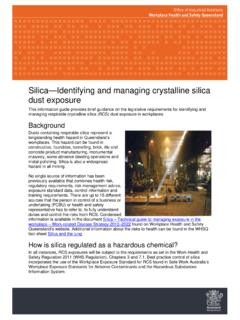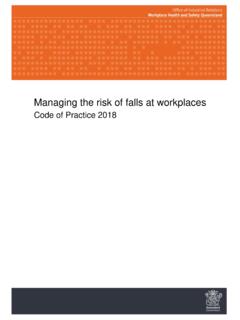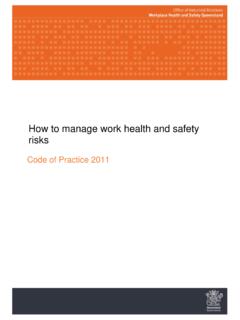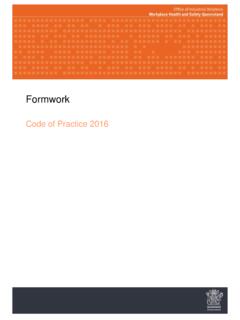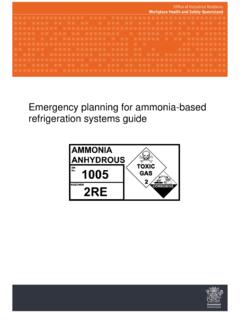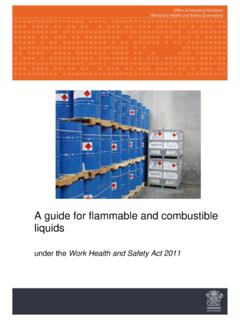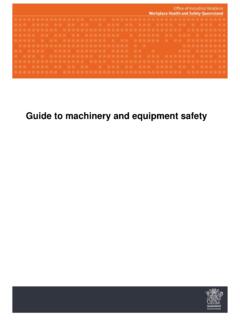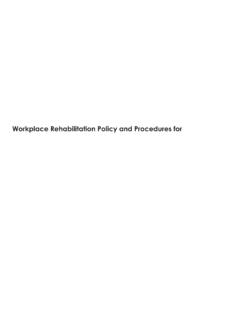Transcription of Managing noise and preventing hearing loss at work Code …
1 Managing noise and preventing hearing loss at work Code of Practice 2021 Managing noise and preventing hearing loss at work Code of Practice 2021 Page 2 of 54 PN12640 ISBN Creative Commons This copyright work is licensed under a Creative Commons Attribution-Noncommercial International licence. To view a copy of this licence, visit In essence, you are f ree to copy, communicate and adapt the work f or non-commercial purposes, as long as you attribute the work to Saf e Work Australia and abide by the other licence terms.
2 Managing noise and preventing hearing loss at work Code of Practice 2021 Page 3 of 54 Contents Foreword .. 4 1. Introduction .. 5 Who has health and safety duties in relation to noise ? .. 5 What is involved in Managing noise and preventing hearing loss?.. 7 Information, training, instruction and supervision .. 8 2. noise and its effects on health and safety .. 9 How does hearing loss occur? .. 9 How much noise is too much? .. 9 Other effects of 11 Working safely in ambient 11 3. The risk management process.
3 12 Identifying the hazards .. 12 How to find noise hazards .. 12 Dealing with noise 14 4. Assessing the risks .. 15 When should a risk assessment be conducted? .. 15 Who can do a noise assessment? .. 15 How should a noise assessment be done? .. 16 What information should be included in a noise assessment report? .. 17 5. Controlling the risks .. 18 Hierarchy of control measures .. 18 Maintaining and reviewing control measures .. 21 Personal protective equipment (PPE) .. 22 Audiometric testing .. 24 6. Role of designers, manufacturers, importers, suppliers and installers of plant, substances or structures.
4 26 Designers .. 26 Manufacturers, importers, suppliers and installers of plant, substances or structures 29 What information should be provided to potential users?.. 30 Appendix A Glossary .. 32 Appendix B Other causes of hearing loss in the workplace .. 35 Vibration .. 35 Ototoxic 35 Acoustic shock .. 37 Appendix C noise hazard identification checklist .. 40 Appendix D Ready reckoner .. 41 Appendix E Content of a noise assessment report .. 46 Appendix F Engineering control measures .. 48 Managing noise and preventing hearing loss at work Code of Practice 2021 Page 4 of 54 Foreword This Code of Practice on Managing noise and preventing hearing loss at work is an approved code of practice under section 274 of the Work Health and Safety Act 2011 (WHS Act).
5 An approved code of practice is a practical guide to achieving the standards of health, safety and welfare required under the WHS Act and the Work Health and Safety Regulation 2011 (WHS Regulation). Under section 26A of the WHS Act duty holders must comply with an approved code of practice or follow another method, such as a technical or industry standard, if it provides an equivalent or higher standard of work health and safety than the standard required in this code. A code of practice applies to anyone who has a duty of care in the circumstances described in the code.
6 In most cases, following an approved code of practice would achieve compliance with the health and safety duties in the WHS Act, in relation to the subject matter of the code. Like regulations, codes of practice deal with particular issues and do not cover all hazards or risks that may arise. The health and safety duties require duty holders to consider all risks associated with work, not only those for which regulations and codes of practice exist. Codes of practice are admissible in court proceedings under the WHS Act and WHS Regulation. Courts may regard a code of practice as evidence of what is known about a hazard, risk or control and may rely on the code in determining what is reasonably practicable in the circumstances to which the code relates.
7 An inspector may refer to an approved code of practice when issuing an improvement or prohibition notice. This may include issuing an improvement notice for failure to comply with a code of practice where equivalent or higher standards of work health and safety have not been demonstrated. Scope and application This Code is intended to be read by a person conducting a business or undertaking (PCBU). It provides practical guidance to PCBUs on how to manage health and safety risks associated with workplace noise . This Code may be a useful reference for other persons interested in the duties under the WHS Act and the WHS Regulation.
8 This Code applies to all workplaces covered by the WHS Act where exposure to hazardous noise may occur. Although the WHS Regulations for noise are limited to Managing the risks of hearing loss, the duties in the WHS Act extend to all health and safety risks arising from the conduct of a business or undertaking and therefore this Code also includes information about other agents that may contribute to hearing loss in Appendix B Other causes of hearing loss in the workplace. How to use this Code of Practice This Code includes references to the legal requirements under the WHS Act and WHS Regulations.
9 These are included for convenience only and should not be relied on in place of the full text of the WHS Act or WHS Regulation. The words must , requires or mandatory indicate a legal requirement exists that must be complied with. The word should is used in this Code to indicate a recommended course of action, while may is used to indicate an optional course of action. Managing noise and preventing hearing loss at work Code of Practice 2021 Page 5 of 54 Introduction Hazardous noise can destroy the ability to hear clearly and can also make it more difficult to hear the sounds necessary for working safely, such as instructions or warning signals.
10 Managing the risks related to noise will assist in: protecting workers from hearing loss and disabling tinnitus (ringing in the ears or head) improving the conditions for communication and hearing warning sounds creating a less stressful and more productive work environment. Who has health and safety duties in relation to noise ? Duty holders who have a role in Managing the risks of noise include: persons conducting a business or undertaking (PCBUs) designers, manufacturers, importers, suppliers and installers of plant, substances or structures officers.
